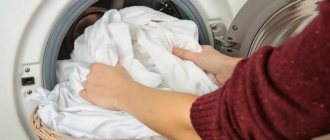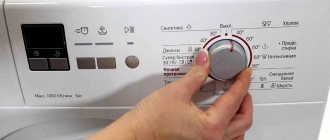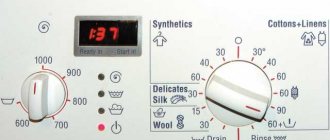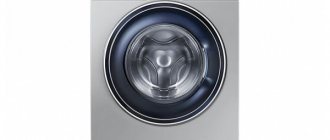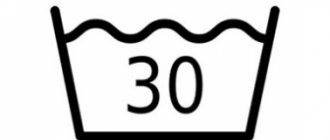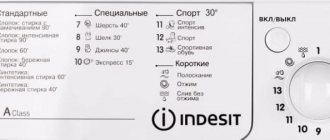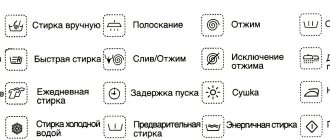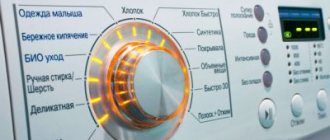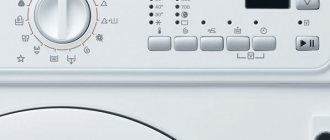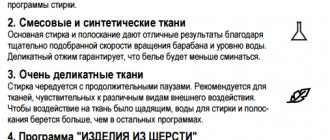Immediately after purchasing a new washing machine, the question arises - how to operate it correctly. Each model has its own subtleties in the designation of washing modes and various functions. For some units, all levers and buttons are labeled in Russian, for others - in English, and for others, on the panel you can find icons in combination with inscriptions or even just pictures.
Quite often, washing modes and other additional functions are indicated on the control panel of the washing machine using icons
How to understand the icons on the washing machine? The obvious answer to this question is that you need to read the instructions. What if the document is lost or you received the machine without instructions? In our article we will talk about the symbols on washing machines: common to many brands and used by individual manufacturing companies.
What are the icons on the washing machine
All washing machines are equipped with regular buttons or a touch screen. The general principle of operation is similar, so it will not be difficult to understand. In addition, many of the icons are similar to the dishwasher icons.
Most of the icons are equipped with special symbols that simplify the use of the machine. Possible washing modes are usually located around a convex drum-shaped handle.
Even without instructions, you can intuitively understand the purpose of a particular button. Associations are used to simplify use. For example, delicate washing is usually indicated by a feather or a butterfly.
Many icons can be understood intuitively.
All modes on a washing machine are similar, so any machine has the following buttons:
- On/off. Indicated by the word “Start” or a circle with a line on top.
- Soak, rinse and spin.
- Various washing modes.
Most machines have standard mode designations.
Not all modes can be represented in the form of a graphic image, and the same pictures from different manufacturers may indicate different functions. Therefore, before you start using the machine, you need to study the instructions in detail.
Soak Application Tips
The washing machine manual reveals all possible details of operating the machine. There you can find a detailed description of any function, including the soaking function, as well as information on how to combine and combine modes. It says the following about pre-washing:
- Do not put gel or other liquid products into the main wash compartment (only dry powders, stain removers and bleaches). Otherwise, the product will flow through the pipes into the drum while soaking, and the main wash will be done without any product at all. The same applies to the compartmentand for pre-cleaning, it involves the use of only dry washing mixtures;
- Quick wash modes do not support pre-soak.
At first glance, the “conflict” between soaking and express programs seems strange, but if you think about it, everything is logical. After all, the essence of fast modes is speed, and prewash can extend the cycle up to two hours. If things are seriously dirty, you will have to choose a different program.
Basic symbolism
The location and meaning of certain buttons vary from manufacturer to manufacturer. Let's look at the signs and symbols on the washing machine of various models.
It happens that different manufacturers have different control symbols for the washing machine.
Bosch
It should be taken into account that on different models of the same Bosch company the panels may be fundamentally different. All symbols are usually divided into groups depending on the degree and type of spin. Let's look at the main ones from the manufacturer Bosch:
- Start is in the center of the panel.
- Contour underwear is cotton clothing.
- A container with a wave on top - wash with plenty of water.
- Empty container - quick wash. Usually 30 minutes.
- Iron - ironing. Don't expect perfectly ironed clothes. The key is the number of revolutions and intensity.
- “T-shirt” is synthetic.
- Nightgown - delicate wash.
- Basin with a ball of washing - wool or hand wash.
- “Pants” – jeans.
The icons may differ on different Bosch washing machine models.
The drawing may look different, you need to find the most suitable one.
Indesit
The manufacturer Indesit cares about convenience and tries to make using the device as easy as possible. Therefore, opposite each button there is a precise description of the function - the name of the program and its number. This greatly simplifies operation.
Indesit took care of the most simple notations that do not require decoding.
Basic symbols:
- Cotton pattern - natural fabrics.
- Triangle - synthetic.
- Curtains - curtains.
- The plant is a mode of increased economy.
- Flower - delicate wash.
- Trousers - washing jeans.
- A ball of thread - washing wool.
- Iron - ironing.
- Dial - quick wash.
The power button is on the side.
There is also a power button on the side. It can be round or square.
Samsung
This model may have no raised symbols at all, but only a touch screen. The following images can be selected as standard:
- T-shirt with the bottom corner painted over - intensive wash.
- Dial – delay start.
- T-shirt with soap bubbles - wash with a lot of foam.
- Container with a wave - soaking.
Samsung has several standard designations.
A big advantage is the presence of the “lock with a smiling face” symbol – child protection. That is, you can protect the device from unexpected impacts from a child, who can not only damage the machine, but also get injured.
LG
The manufacturer LG does not have icons, but under this or that program there is an exact description of the function. The drum can be used to regulate the degree and intensity of washing, drainage mode and more. It is possible to select the temperature, delay the start and protect the machine from children.
LG doesn't have icons as such.
Ariston
This brand has fundamental differences from others. They are expressed in:
- A container with water and a vertical stripe - soaking.
- Container with a wave - rinsing.
- Moon and stars – night mode without draining and minimal noise level.
- Container with only a vertical stripe - treatment before washing.
- Bed sheets.
- “M” is a personal program that can be added to simplify the process.
- Cotton is a natural thing.
- The flask is synthetic.
- Flower - gentle wash.
- Plant – economical mode.
- Iron - ironing.
- Handwash.
- A skein of yarn is wool.
- Pants - jeans.
- Curtains or drapes.
- Basin and arrow pointing down – drain.
Ariston has quite a few different designations.
In addition, you can find a button with two parallel lines, which allows you to pause the process and continue after a while.
Zanussi
In addition to the usual on and off buttons, you can find the following symbols:
- Cotton – items made from natural fabric.
- Chemical flask - synthetic.
- Flower - delicate care.
- Container and hand – manual mode.
- Snowflake - cold water.
- A skein of yarn - washing wool.
- A container with an arrow pointing downwards is a drain.
- Spring – no spin.
- Lock – protection against child intervention.
- A container with a horizontal stripe means stopping the process.
- Container with a wave - rinsing.
Decoding Zanussi symbols is quite simple.
Typically, all these symbols are located around the reel or on the touchpad.
Candy
This manufacturer has tried to simplify use as much as possible, so the icons are very simple and common. But there are exceptions:
- Droplets of water - rinse again.
- Dirty T-shirt - intensive wash.
- Clock – delayed start.
- An empty basin with a stream of water - rinsing.
- “P” in the basin – pre-wash.
- Basin with number 32 - quick wash.
- Feather – delicate mode.
- Cloud - durable fabrics.
Some Kandy icons can be difficult to understand.
These icons are not found on other models, so you need to learn their functions to avoid difficulties. The operating principle is similar to the Beko machine.
Drying products
The washing process without spin means that items will contain excess moisture after being unloaded from the machine drum. You can remove it by first drying it in a terry towel.
Woolen products are first dried on a horizontal surface, placing a dense, dry, lint-free cloth underneath. The item is straightened out, restoring its shape, avoiding creases. In the process of absorbing moisture, the lining is changed to dry.
Silk, viscose, chiffon blouses are dried without direct sunlight, in the open air. The product is transferred to a vertical position only after complete drying, choosing wide hangers for storage.
Do you wash by hand?
Oh yes! No
Display Features
Here you need to pay attention to how the information is displayed and whether there is a backlight.
Important! The presence of a backlight will greatly simplify the use of the device, since even with the light turned off, everything will be perfectly visible.
The display can be either backlit or without it.
It is better to give preference to regular buttons, since the touch display may be faulty and its repair is much more difficult. It is recommended to choose those models that indicate the washing time and temperature, as this will greatly simplify the process.
Purpose
In some cases, it may be necessary to rinse the laundry more thoroughly than suggested by the program. In such situations, an “extra rinse” comes to the rescue.
In most washing machines, this option can be activated by pressing only one button on the control panel.
It can be called “extra rinse”, “super rinse” or indicated by a characteristic symbol - a container with a wave or dashes , simply wavy lines imitating the surface of the water.
This mode makes it possible to rinse the laundry more thoroughly – more than once. In this case, the rinsing stage takes place fully - with the addition of water, rotation of the drum and draining.
Explanation of symbols
To operate the machine correctly, it is worth studying not only the symbol, but also the exact use of temperature, type of wash, and so on. Let's take a closer look.
Work processes
Modern models of washing machines perform many functions, in addition to the usual cleaning of clothes. Studying the work process will allow you to keep things in their original form.
The washing machine works according to a certain principle. First you need to load a certain type of clothing (natural fabrics, wool or something else). After this, powder for the machine and conditioner, if necessary, are poured into a special hole. Now you need to decide on the washing mode and start the process. After some time, the device will notify you that the work has finished. If necessary, you can repeat the rinsing or spinning.
Washing in a washing machine occurs in several stages.
Most models have a delayed start or night wash function, which is very convenient for busy people.
Water temperature
Particular attention must be paid to the water temperature, as certain types of clothing can only be washed in warm or only in cold water. The required degrees are set automatically when selecting a mode.
But some models allow the owner to independently set the required temperature. For this purpose, there is a special manual drum on the panel of the washing shirt, which allows you to adjust the degree of water displayed on the display.
You can adjust the water temperature yourself using the drum.
Types of washing
In order not to spoil the item and maintain its appearance, you need to choose the right type. There are quite a lot of them, as well as types of fabric.
Most washing machines have the following modes, depending on the number of revolutions and duration:
- Preliminary. Even the most stubborn stains are removed faster and more effectively.
- Manual. Used for the most delicate items, stain removal is usually carried out at room temperature.
- Delicate. She can also be called careful. Used for silk, cashmere.
- Fast. Washing takes from 15 to 30 minutes and is done in accelerated mode.
- Economical. Cleaning stains occurs as quickly as possible with little consumption of water and electricity. This reduces utility costs. It is also called electrolux.
- Night. It is a great help for housewives when there is no time to load things during the day. The machine operates in quiet mode without draining.
- Intense. Used for heavy soiling.
The machine has several washing modes.
You also need to sort items by fabric type. In accordance with this sorting, washing machines have special functions that are ideal for a particular type of item. You can highlight synthetics, cotton, wool, fine linen, denim, thick fabrics, sportswear, children's clothes, curtains, blankets and bed linen, winter clothes.
What items should be washed in this mode?
An informal list of delicate fabrics and items is formed based on experience working with them. It is supplemented and adjusted. Usually these are complex products with many bright inserts and accessories, underwear, curtains, curtains, fabric sneakers, soft toys. This includes thermal underwear, fabrics with pleated effect, rhinestones, and other decorations.
The following materials are considered delicate:
- Silk.
- Chiffon.
- Batiste.
- Wool.
- Guipure.
- Atlas.
- Viscose.
- Lace.
- Polyester.
- Cashmere.
- Elastane.
- Knitwear.
- Microfiber and new generation fabrics.
You can recognize the material by its appearance or try washing a piece of similar fabric. If it turns out that a thing stretches, tears, or sheds, you need to take special care of it.
If the type of material is not determined, starch paste will remove heavy contamination. It must be applied to the stain, allowed to dry, and cleaned off with a sponge. Then the item must be washed in a neutral substance: soap, baby shampoo.
Additional functions
In addition to all of the above, some models also have additional functions. Thus, many machines are equipped with antibacterial treatment. In this case, the water temperature rises very strongly - up to 90 degrees.
If the powder is not washed enough, you can use the additional rinse function. To make things less wrinkled, you can turn on ironing, which is shown as an iron.
Some machines have an additional rinse function. The washing machine can be protected from children’s games; to do this, you need to press the lock, which will lock the device and the child will not be able to get hurt.
Water temperature
Most units automatically offer independent temperature control, at which things will not deteriorate.
Some models have default temperature settings for a specific fabric type.
On the washing machine, this icon looks like a basin with a number inside. The equipment can also be equipped with a circular regulator on which temperature marks are set if it does not have an electronic display with buttons.
How to choose the right mode
When choosing a mode, you need to sort things. It is recommended to arrange them by color and type of fabric. You need to select a mode in accordance with these parameters.
Note! It is recommended to wash children's clothes separately, as they require thorough soaking and rinsing.
You definitely need to pay attention to the washing rules; to do this, you should study the tags on the clothes. Here you can find valuable instructions on temperature and the possibility of using a rinse.
It is better to choose the washing mode in accordance with the labels on the clothes.
Dry cleaning icon
Circle - the dry cleaning icon means removing dirt and stains on items that cannot be washed with regular washing using solvents.
There are two types of chemical treatment of fabric:
- Dry cleaning uses a specific solvent suitable for the specific material. Includes the stage of removing dirt, followed by rinsing, spinning and drying until the detergent evaporates.
- When wet cleaning, items are treated with water according to a special technology, and detergent additives are used that minimize the negative consequences of cleaning delicate fabrics. This procedure completely eliminates the use of aggressive detergents.
Minor stains usually do not require professional cleaning. According to the icons on the clothes, dry cleaning can be done at home; see how to do this in the video below.
What are fault codes
Sometimes some problems may arise; in order to eliminate them, you need to study the fault codes. They always light up when a fault occurs. Depending on the symbol, you can quickly determine the cause and find a solution.
It should be taken into account that not all models are equipped with this function, but it will be a significant advantage. Let's look at the codes using the example of the manufacturer SAMSUNG:
- UE - problems with the drum. You need to stop work and take out the laundry.
- EE - breakdown of the water heater or thermometer.
- OE (OF) - too much water.
- LE - water flow.
- HE - discrepancy between the set temperature.
- CE - malfunction of the temperature sensor.
- AE - malfunctions in the processor.
- UC - network outage.
All these codes are described in detail in the instructions that come with the device.
Fault codes for Samsung automatic machines
If a problem occurs, the automatic machine will definitely inform the owner about it. For machines with a display, an error code will immediately appear on the screen; the old model will indicate this by flashing lights on the panel. Note that modern models have a larger number of fault codes. Let's figure out what this or that code means.
| Code on display | What indicators light up on the panel | What's happening |
| 5E, 5C, E2 | all washing programs + second from bottom water heating. | Water is not draining from the machine. |
| H1, H2, NOT, HE1, HE2, NS, NS1, NS2, E5, E6 | all washing programs + bottom and second from top water heating or all washing programs + two central water heating. | The water does not heat up. |
| 4E, 4C, E1 | all washing programs + lower water heating. | Water does not fill into the car. |
| 4C2 | all washing programs + top water heating. | Too hot water is poured in – above 50 °C. |
| SUD, 5D (SD) | – | Excessive amount of foam in tank. |
| UE, UB, E4 | all washing programs + second from top water heating. | The items inside the drum are not evenly distributed. |
| LE, LC, E9 | all washing programs + lower and upper water heating. | The water drains spontaneously. |
| 3E, 3E1, 3E2, 3E3, 3E4, 3C, 3C1, 3C2, 3C3, 3C4, EA | – | Overloaded, blocked by something or the motor is broken. |
| UC, 9C | – | The power supply voltage is too low or too high. |
| DE, DE1, DE2, DC, DC1, DC2, ED | all washing programs + all water heating. | The hatch door is open. |
| DC3 | – | The Add Door is open. |
| DDC | – | The “Add Door” is not opened correctly during washing. |
| LE1, LC1 | – | There is water at the bottom of the car. |
| TE, TE1, TE2, TE3, TC, TC1, TC2, TC3, TC4, EC | – | The temperature sensor does not give a signal. |
| 0E, 0F, 0C, E3 | all washing programs + two lower water heating. | Too much water in the car. |
| 1E, 1C, E7 | all washing programs + three lower water heating. | The water level sensor does not give a signal. |
| BE, BE1,BE2, BE3,BC2, EB | all washing programs + two lower and upper water heating. | One or more buttons on the control panel do not work. |
| AE, AC, AC6 | – | There is no connection between electrical boards. |
| CE, AC, AC6 | – | The water temperature before draining is too high (55 degrees or more). |
| 8E, 8E1, 8C, 8C1 | – | The vibration sensor “VRT+” does not work. |
| E.E. | – | The drying temperature sensor does not work (if the drying function is present). |
| F.E., F.C. | – | The dryer does not work (if there is a drying function). |
| SDC | – | The automatic dispenser does not work (with Wi-Fi function). |
| 6C | – | The auto dispenser drive or wiring is faulty (if Wi-Fi enabled). |
| 2H, 3H, 4H | – | Remaining time until the end of the wash. |
| Hot | – | The temperature in the drum is higher than normal (if there is a drying function). |
| A0…A9, B0, C0, D0, E0 | – | Work in factory test mode. |
| PoF | – | The electricity is turned off during washing (the error appears when the electricity is turned on). |
| B.C. | – | The engine does not start. |
Nuances when starting washing for the first time
When buying a new washing machine, you want to try the device in action as quickly as possible. First of all, you need to make sure that the connection and installation are correct. If you make any mistakes, it can lead to water leakage or even breakdown. It is necessary to check that the machine is stable and that there are no foreign objects in the drum.
After purchasing a new machine, the question arises what the icons on the washing machine mean. To do this, you need to study the instructions in detail, and in the absence of them, study the relevant articles on the Internet.
Requirements for washing powder
A properly selected detergent must meet the following requirements:
- The powder should be easily soluble in water.
- It is necessary to exclude the situation when, after the end of the procedure, unwashed grains of powder remain among the fibers of the fabric.
- The presence of aggressive components in the detergent is unacceptable: enzymes, chlorine or the like.
- As a result, the color of the laundry should not change.
- If the selected washing powder gives clothes an unpleasant odor, then it will not be suitable for items made of delicate fabrics.
- After completing the procedure, the washed laundry should not become rough or hard to the touch. It is necessary that it remains soft and tender.
Prohibitions on using the program
Spin is a useful function, but it cannot always be used. For many types of things and fabrics, this mode cannot be used at all or is possible, but with restrictions.
Such information is indicated on the labels of clothing. In addition, a number of modes built into an automatic washing machine already have a spin limitation program.
If this option is not provided by the program, then, having finished rinsing, the device simply drains the water without performing any further actions.
How to use the option
Additional rinse steps when this option is in addition to the standard program:
- Putting things in a drum.
- Pouring detergent into the cuvette.
- Selecting a washing mode from the proposed list of programs.
- Selecting an additional rinse on the control panel.
- Starting the wash.
After this, the automatic washing machine begins to do its job, taking into account the additional parameter set by the user.
In this case, the process is carried out in stages:
- water intake into the drum;
- washing with hot water;
- draining;
- taking a new portion of water;
- performing rinsing;
- draining;
- set of additional portions of water;
- additional rinsing;
- draining;
- spin
In combination washing machines with drying, the laundry may begin to dry after spinning.
Another possible option for using an additional rinse cycle can occur when the laundry has already been removed from the drum. If you need to rinse it further, you can return the items to the washing machine and set it to rinse and spin only.
Recommendations for choosing a class
Choosing a washing machine based on how fast the drum spins makes you wonder if it's worth paying more to get drier clothes after washing. If drying things in the air is problematic (little space, humid climate, etc.), then a high spin class will be simply necessary.
A and B make the laundry almost dry . But using the option to the maximum can also damage thin and delicate material. If you don’t plan to often use maximum speed, then you can choose a washing machine with a lower class without overpaying for an unclaimed option.
Classes C and D are considered to be European standards. This is the best option for mid-latitudes. The laundry that comes out of the drum is still damp, but can be completely dried by hanging it in the air.
F and G are the most modest option , which is sold in cheap models of washing machines. This washing machine is more suitable for hot regions with high air temperatures.
The classification of spin levels and their letter coding helps to simplify the selection problem and make the right decision when purchasing a washing machine.
